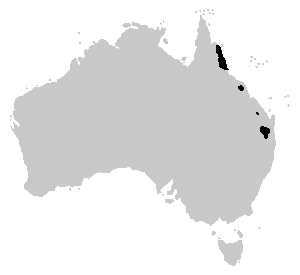Taudactylus facts for kids
Quick facts for kids Taudactylus |
|
|---|---|
 |
|
| Eungella torrent frog, Taudactylus eungellensis | |
| Scientific classification |
|
| Kingdom: | Animalia |
| Phylum: | Chordata |
| Class: | Amphibia |
| Order: | Anura |
| Family: | Myobatrachidae |
| Subfamily: | Myobatrachinae |
| Genus: | Taudactylus Straughan & Lee, 1966 |
| Species | |
|
6 species (see text) |
|
 |
|
| Range of Taudactylus | |
Taudactylus is a special group of frogs. They belong to the family Myobatrachidae. These frogs live only in the rainforests along the coast of eastern Australia. Most of them prefer to live in fast-flowing streams in high areas.
Sadly, many Taudactylus species have faced serious problems. A disease called chytridiomycosis seems to be a big reason for their decline. For example, T. diurnus is believed to be extinct. Almost all other species are listed as critically endangered by the IUCN. It's even possible that T. acutirostris, which is listed as critically endangered, might already be extinct.
Contents
What Makes Them Special?
Taudactylus frogs are easy to spot because of a unique T-shaped pad on the end of each of their fingers and toes. This helps them hold on in fast-moving water. They are all small frogs, growing no larger than 40 millimeters (about 1.5 inches) long. Their fingers and toes do not have webs between them. Their skin is usually smooth.
These frogs have a large tympanum, which is like an eardrum. It can be seen or hidden. They don't have vocal sacs, but all species are known to make calls. The Eungella Torrent Frog is the only frog in its family known to show it's there by moving its body.
Where Do They Live?
Of the six species in the Taudactylus group, two live only in the Wet Tropics of Queensland, Australia. This area is known for its ancient rainforests. For example, T. rheophilus was found in places like the Bellenden Ker Range. However, its numbers have dropped greatly.
Before 1988, T. acutirostris lived in streams throughout the World Heritage Area. But since then, its numbers have fallen dramatically. Its situation is now considered very serious.
Why Are They Disappearing?
The big drop in frog numbers in the Wet Tropics has been linked to a fungal disease. This disease is caused by a fungus called Batrachochytrium dendrobatidis.
Finding the Cause of Frog Declines
In 1992, scientists were doing an experiment to find out why T. acutirostris populations were shrinking. They collected frogs and tadpoles from a stream. They placed them in special observation areas at five sites where the frogs had disappeared. They also had a control area at the collection site.
During this experiment, scientists Michael Mahony and Andrew Dennis saw sick and dying frogs. This included T. acutirostris and other stream frogs. They collected samples and sent them to experts at James Cook University. This was the first time anyone in Australia had seen the direct cause of these frog declines. It led to the discovery that the fungal pathogen (Batrachochytrium dendrobatidis) was the problem.
Species of Taudactylus Frogs
There are six known species in the Taudactylus group:
| Common name | Binomial name |
|---|---|
| Sharp-snouted torrent frog | Taudactylus acutirostris (Andersson, 1913) |
| Mount Glorious torrent frog | Taudactylus diurnus Straughan & Lee, 1966 (extinct) |
| Eungella torrent frog | Taudactylus eungellensis Liem & Hosmer, 1973 |
| Liem's frog | Taudactylus liemi Ingram, 1980 |
| Kroombit tinker frog | Taudactylus pleione Czechura, 1986 |
| Tinkling frog | Taudactylus rheophilus Liem & Hosmer, 1973 |
See also
 In Spanish: Taudactylus para niños
In Spanish: Taudactylus para niños

